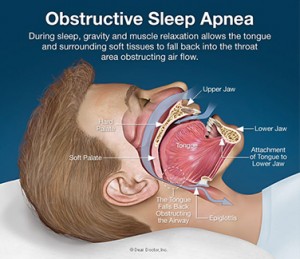
Sleep apnea is a condition where your breathing stops or slows down while you sleep. The pauses can last from a few seconds to almost a minute.
People with obstructive sleep apnea (OSA) have disrupted sleep and low blood oxygen levels. When obstructive sleep apnea occurs, the tongue is sucked against the back of the throat. This blocks the upper airway and airflow stops. When the oxygen level in the brain becomes low enough, the sleeper partially awakens, the obstruction in the throat clears, and the flow of air starts again, usually with a loud gasp.
Repeated cycles of decreased oxygenation lead to very serious cardiovascular problems. Additionally, these individuals suffer from excessive daytime sleepiness, depression, and loss of concentration. Recent Studies have shown that patients with obstructive sleep apnea are at increased risk for high blood pressure, stroke, heart disease, diabetes and depression.
Sleep apnea is a very common condition but unfortunately most patients with sleep apnea are not aware that they have a problem. The only way to diagnose sleep apnea is with an overnight sleep study. The key is to determine who is a risk for sleep apnea and referring this individuals to be tested.
Dr. O’halloran and Egan use a detailed history and thorough physical exam to determine if a patient is a candidate for a sleep study. The doctors will assess the anatomic relationships in the maxillofacial and nasal airway. Sometimes a naso-pharyngeal exam is done with a flexible fiber-optic camera.
A sleep study or polysomnogram is an overnight sleep test that physicians often prescribe to patients with sleep disorders. The polysomnogram, often called a PSG, measures and records activity during sleep. The PSG monitors many body functions such as brain activity, eye movements, muscle activity, respiratory airflow, and heart rhythm during sleep.
It is important to remember that a polysomnogram is a not a test, but instead a painless, in-depth recording of how well you sleep.
After you complete your overnight polysomnogram, our board certified sleep medicine physician will review the data collected to look for sleep apnea. The polysomnogram will also reveal the severity of the disorder and give the physician guidance to the proper treatment to prescribe.
If the results of your polysomnogram reveal that you have sleep apnea you doctor will likely recommend that you have a CPAP Titration. The CPAP Titration is identical to a polysomnogram with the addition of a medical device known as a continuous positive airway pressure machine (CPAP). This machine blows pressurized air into the nose via a mask in order to eliminate the snoring and pauses in breathing that sleep apnea produces.
The CPAP Titration is an overnight sleep study used to determine the minimal effective pressure to eliminate the sleep breathing disorder. The test also ensures that you have been given a comfortable mask that will produce the best possible results. An initial treatment may consist of using a nasal CPAP machine that delivers pressurized oxygen through a nasal mask to limit obstruction at night. CPAP is the most effective treatment option for sleep apnea.
If a patient cannot tolerate a CPAP mask or is unwilling to use a CPAP mask there are other options available.
One of the surgical options is an uvulo-palato-pharyngo-plasty (UPPP), which is performed in the back of the soft palate and throat. At the same time a radio-frequency probe is often utilized to reduce the size of the back of the tongue, a major source of obstruction
Another option is an oral appliance that is worn at night and pulls the jaw and tongue forward slightly to increase the size of the airway. OSA is a very serious condition that needs careful attention and treatment. Most major medical plans offer coverage for diagnosis and treatment.